Leverage
To hit a 100+ mph kick serve over someone's head or make a drop volley bounce back towards the net you must apply leverage. All of these and many more tennis techniques require extraordinary racket head speed. That would not be a problem if you had the entire stroke to accelerate the racket, but you don't. The annoying requirement that you have some modicum of "control" over the flight path of the ball means that you can't start accelerating the racket head until after the Lock phase and must end acceleration before the moment of contact so that the stored control forces can be released into the ball during the Explode phase. Therefore all of the racket head speed must be developed during the Load and Lag phases - total duration about .25 seconds. During that time the racket's inertia makes it feel like it weighs 15 pounds - that is if you are only pulling the racket in a straight line. If you are also pushing the racket head around the wrist at the same time the moment of inertia of the racket head at the end of your arm and racket makes it seem much heavier. How, then, do you most efficiently get the racket "up to speed." The key is to optimize leverage during each phase of the stroke. Your joints all operate with a mechanical advantage that is less than 1.0, meaning that a large force from the muscle acts over a short distance to create a smaller force at the other end of the bone over a longer distance. Contrast this with a pry bar, where a small force over a longer distance results in a larger force over a smaller distance. Both are examples of leverage, and since our goal is to get the racket head moving as fast as possible, leverage is good. Leverage requires a rotational force or torque and a lever arm of some length. The longer the lever arm, the greater the leverage. In the context of our limbs that means we can accelerate the racket head, at the end of the lever, to a speed that is much faster than our limbs can move. So our limbs are 'step-up speed' levers, but they are also 'step-down force' levers. Early in the acceleration phase, the racket feels quite heavy due to inertia, so early on we need a short lever arm to get it going. Once it is moving, we must gradually lengthen the lever to maximize racket head speed. Varying lever length is also necessary because the torque applied to the driving end of the lever is not constant, it depends on how fast the muscle is contracting. That means that ideally, we should have a shorter lever arm to begin with and lengthen it over time, like up-shifting gears on a bicycle as we speed up. Second, power coming from the lower body arrives at the arm in a wave which builds, crests and ebbs over time, so changing leverage is one way to optimize power transfer to the ball. Increasing the length of the lever arm during a stroke is the main way that A-players develop their remarkable racket head speed and pace on the ball. There are two principal techniques that anybody can use to optimize leverage; lagging and extension.
Lagging
Lagging means dragging the racket behind the wrist during the acceleration phase of the stroke. Lagging is the polar opposite of pushing the racket at the ball. When you lag you pull on the handle of the racket along its shaft. Just prior to the moment of contact the main lever arm will slow and the wrist becomes the center of rotation so the racket will come around the wrist into the ball with excellent racket head speed. The action resembles an effective sabre-cut. Lagging also protects your arm from the ill effects of pushing the racket head into the ball.
Extension
Another helpful technique for developing power is extension. If lagging happens mostly at the wrist, extension happens at the elbow. Most full strokes start with a bent elbow and end with a straight one thus lengthening the lever arm and thereby increasing leverage as the power wave crests in the forearm. Note that as the lever arm increases in length the force at the end decreases but the linear speed of the end increases. The ability to trade force for speed is advantageous because we are trying to develop racket head speed, not force; the only forces we care about at contact are the stored control and spin forces which are stored primarily in the forearm, not sourced in the body.

